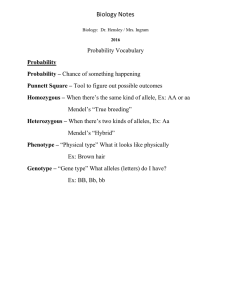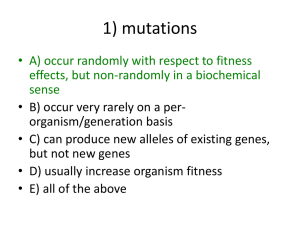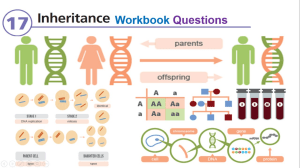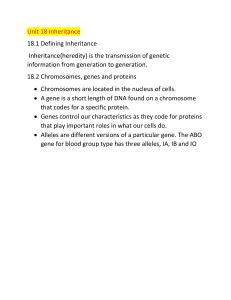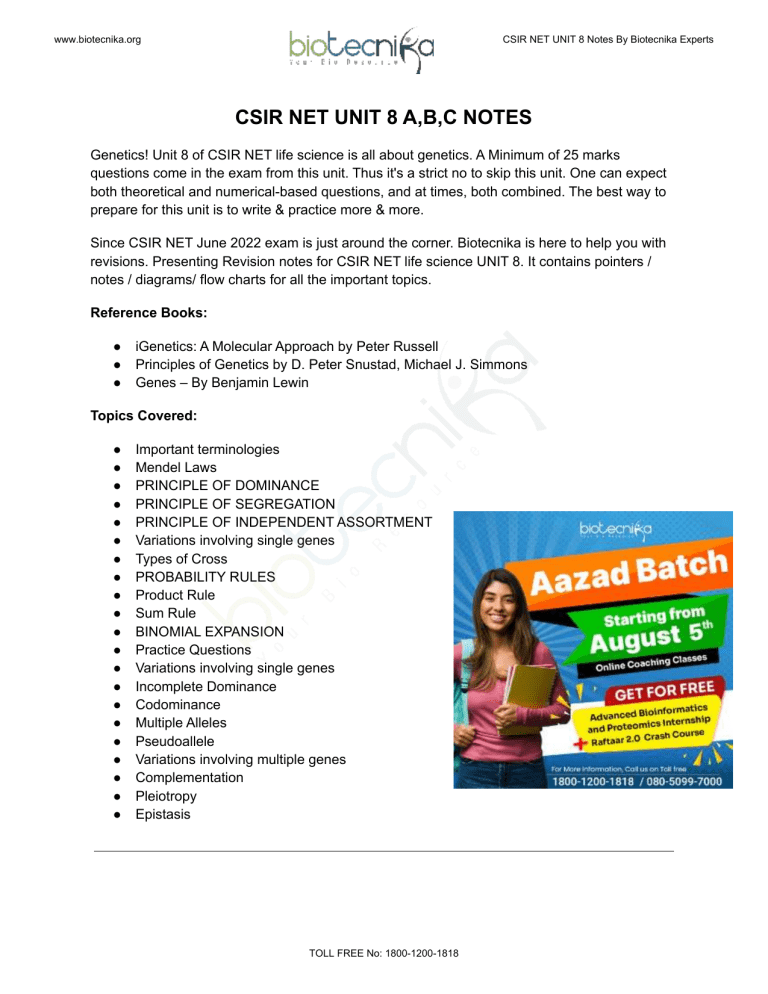
www.biotecnika.org CSIR NET UNIT 8 Notes By Biotecnika Experts CSIR NET UNIT 8 A,B,C NOTES Genetics! Unit 8 of CSIR NET life science is all about genetics. A Minimum of 25 marks questions come in the exam from this unit. Thus it's a strict no to skip this unit. One can expect both theoretical and numerical-based questions, and at times, both combined. The best way to prepare for this unit is to write & practice more & more. Since CSIR NET June 2022 exam is just around the corner. Biotecnika is here to help you with revisions. Presenting Revision notes for CSIR NET life science UNIT 8. It contains pointers / notes / diagrams/ flow charts for all the important topics. Reference Books: ● ● ● iGenetics: A Molecular Approach by Peter Russell Principles of Genetics by D. Peter Snustad, Michael J. Simmons Genes – By Benjamin Lewin Topics Covered: ● ● ● ● ● ● ● ● ● ● ● ● ● ● ● ● ● ● ● ● ● Important terminologies Mendel Laws PRINCIPLE OF DOMINANCE PRINCIPLE OF SEGREGATION PRINCIPLE OF INDEPENDENT ASSORTMENT Variations involving single genes Types of Cross PROBABILITY RULES Product Rule Sum Rule BINOMIAL EXPANSION Practice Questions Variations involving single genes Incomplete Dominance Codominance Multiple Alleles Pseudoallele Variations involving multiple genes Complementation Pleiotropy Epistasis TOLL FREE No: 1800-1200-1818 www.biotecnika.org CSIR NET UNIT 8 Notes By Biotecnika Experts Introduction To Genetics GENETICS is the branch of biology that deals with the heredity and variation of organisms. Chromosomes carry the hereditary information (genes) ● ● DNA -> RNA -> Proteins Chromosomes (genes) occur in pairs HOMOLOGOUS CHROMOSOMES Homologous chromosomes contain DNA that codes for the same gene. Terminologies: ● ● ● ● ● ● ● ● Sister chromatids are two identical copies of the same chromosome formed by DNA replication, attached by a structure called the centromere. Gene – Unit of heredity; a section/region of the DNA sequence encoding a single protein Genome – Entire set of alleles that an individual possesses Alleles – One of two or more alternate forms of a gene Two genes occupy the same position on homologous chromosomes and cover the same trait (like ‘flavors’ of a trait). Locus –The fixed location on a strand of DNA where a gene or one of its alleles is located. Homozygous - Individuals with two copies of the same allele of a particular gene are said to be homozygous for that gene. Heterozygous - Plants with two different alleles of a particular gene are said to be heterozygous. TOLL FREE No: 1800-1200-1818 www.biotecnika.org ● ● CSIR NET UNIT 8 Notes By Biotecnika Experts Dominant - Allele of a gene that masks or suppresses the expression of an alternate allele; trait appears in heterozygous condition. Recessive - An allele masked by the dominant allele; does not appear in the heterozygous condition, only in homozygous. Fig: Dominant and recessive alleles of a gene for seed shape in pea For example, ● ● ● true-breeding, smooth-seeded peas have the genotype SS, and true-breeding wrinkle-seeded peas have the genotype ss; both are homozygous. The smooth parent is homozygous dominant; the wrinkled parent is homozygous recessive. In our example, the S allele was dominant to the s allele, so in the heterozygous condition, the seed is smooth. Therefore, the homozygous dominant SS and the heterozygous Ss seeds have the same phenotype (smooth), even though they differ in genotype. GREGOR JOHANN MENDEL ● ● ● ● ● ● ● Austrian Monk, Son of a peasant farmer At 21, he was admitted to a Catholic Monastery in Brunn (Czech Republic). Went to the university of Vienna, where he studied botany and learned the Scientific Method Began a series of breeding experiments with the garden pea Pisum sativum to learn about the mechanisms of heredity in 1854. Completed his experiments in 1864. Published his work in 1865 in Natural History Society. Developed theory to explain the transmission of hereditary characteristics from generation to generation. TOLL FREE No: 1800-1200-1818 www.biotecnika.org CSIR NET UNIT 8 Notes By Biotecnika Experts MODEL PLANT: Pisum sativum ● ● ● ● ● Easy to cultivate Had a relatively short life cycle, it Bears flowers and fruit in the same year a seed is planted, producing many seeds. Pea flowers contain both male and female organs. Pollination of the plant was easy to control. Many distinguishable characteristics SEVEN CHARACTER PAIRS IN THE GARDEN PEA WERE STUDIED BY MENDEL IN HIS BREEDING EXPERIMENTS Mendel selected seven pairs of traits to study in breeding experiments. Each pair affected one characteristic of the plant, with each member of a pair being distinguishable: 1. Flower and seed coat color: grey versus white seed coats, and purple versus white flowers (a single gene controls both these color properties of seed coats and flowers) 2. Seed color: yellow versus green 3. Seed shape: smooth versus wrinkled 4. Pod color: green versus yellow 5. Pod shape: inflated versus pinched 6. Stem height: tall versus short 7. Flower position: axial versus terminal Some more important Terminologies: ● ● ● ● ● ● P generation: Parental generation in breeding experiments. F1 generation (First Filial Generation): The progeny of mating of individuals of the P generation. F2 generation Second Filial Generation): The progeny resulting from interbreeding F1 generation individuals. Genotype: Genetic constitution of an organism. Phenotype: The physical manifestation of a genetic trait results from a specific genotype and its interaction with the environment. True-breeding: A trait studied remains unchanged from parent to offspring for many generations. TOLL FREE No: 1800-1200-1818 www.biotecnika.org CSIR NET UNIT 8 Notes By Biotecnika Experts © www.biotecnika.org © www.biotecnika.org © www.biotecnika.org TOLL FREE No: 1800-1200-1818 www.biotecnika.org CSIR NET UNIT 8 Notes By Biotecnika Experts Mendel Laws: PRINCIPLE OF DOMINANCE ● ● ● In a heterozygote, one allele may conceal the presence of another. In a cross of parents that are pure for contrasting traits, only one form of the trait will appear in the next generation. All the offspring will be heterozygous and express only the dominant trait. PRINCIPLE OF SEGREGATION ● ● ● ● Law of purity of gametes The two members of a gene pair segregate from each other during the formation of gametes in meiosis. As a result, half the gametes carry one allele, and the other half carry the other allele. Recessive traits masked in the F1 from a cross between two true-breeding strains reappear in a specific proportion in the F2. TOLL FREE No: 1800-1200-1818 www.biotecnika.org CSIR NET UNIT 8 Notes By Biotecnika Experts PRINCIPLE OF INDEPENDENT ASSORTMENT Mendel also performed experiments with plants that differed in two traits. He crossed plants that produced yellow, round seeds with plants that produced green, wrinkled seeds. The purpose of the experiments was to see if the two seed traits, color, and texture, were inherited independently. ● ● ● Dihybrid Cross: Mating involves parents that differ in two genes (two independent traits). The alleles of different genes segregate, or as we sometimes say, assort, independently of each other. This principle is another rule of genetic transmission, based. BASED ON THESE RESULTS, MENDEL POSTULATED - Genes get shuffled – these many combinations are one of the advantages of sexual reproduction. PROBABILITY TOLL FREE No: 1800-1200-1818 www.biotecnika.org CSIR NET UNIT 8 Notes By Biotecnika Experts A probability is the ratio of the number of times a particular event is expected to occur to the number of trials during which the event could have happened. P=a/n Probability (P) Number of favorable cases (a) Total number of possible cases (n) Probabilities and the laws of chance are involved in the transmission of genes. PROBABILITY RULES ● ● ● Product rule Sum Rule Binomial Theorem Product Rule ● ● ● “And Rule,” “Multiplication Rule” When the occurrence of one event is independent of the occurrence of other events, the product rule is used. States that the probability of two independent events co-occurring is the product of each of their probabilities. E.g., A cross has been made between 2 plants of genotype AabbCcDd & AaBbCcdd. What is the probability that the offspring will be of genotype aabbccdd? Hint- the four different gene pairs are considered as individual events TOLL FREE No: 1800-1200-1818 www.biotecnika.org CSIR NET UNIT 8 Notes By Biotecnika Experts SUM Rule ● ● ● ● “Addition Rule,” “Either/Or Rule” It is used when events are mutually exclusive. The occurrence of one possibility excludes the occurrence of the other possibilities. States, the probability of occurrence of any mutually exclusive events is the sum of the probabilities of the individual events. Q) A heterozygous pea plant is tall with yellow seeds, TtYy, and is allowed to self-fertilize. What is the probability that an offspring will be either tall with yellow seeds, tall with green seeds, or dwarf with yellow seeds? Hint- the problem includes 3 mutually exclusive events. This problem involves three mutually exclusive events (one trait comes, the other will not), and so we use the sum rule to solve it. First, we must calculate the individual probabilities for the three phenotypes. The outcome of the cross can be determined using a Punnett square. Tall with yellow seeds = 9/(9 + 3 + 3 + 1) = 9/16 Tall with green seeds= 3/(9 + 3 + 3 + 1) = 3/16 Dwarf with yellow seeds = 3/(9 + 3 + 3 + 1) = 3/16 Sum rule: 9/16 + 3/16 + 3/16 = 15/16 = 0.94 = 94% BINOMIAL EXPANSION The binomial theorem is used for unordered events: The probability that some arrangement will occur in which the final order is not specified is defined by the binomial theorem Used to predict the probability of unordered events. P= n!/s!t! X asbt In this equation, P= probability that the unordered no. will occur n= total no. of events s= no. of events in one category t= no. of events in the other category, a= individual probability of s b= individual probability of t TOLL FREE No: 1800-1200-1818 www.biotecnika.org CSIR NET UNIT 8 Notes By Biotecnika Experts Practice Question Q. A recessive inherited disease is expressed only in individuals of blood group O and not expressed in blood groups A,B or AB. Alleles controlling the disease and blood groups are independently inherited. A normal woman with blood group A and her normal husband with blood group B already had one child with the disease. The woman is pregnant for the second time. What is the probability that the second child will also have the disease? 1.½ 2.¼ 3.1/16 - Answer 4.1/64 Variations involving single genes Some of the variations on Mendel’s rules involve single genes. These include: ● ● ● ● ● ● ● ● Incomplete dominance. Two alleles may produce an intermediate phenotype when both are present, rather than one fully determining the phenotype. Codominance. Two alleles may be simultaneously expressed when both are present, rather than one fully determining the phenotype. Multiple alleles. Mendel studied just two alleles of his pea genes, but real populations often have multiple alleles of a given gene. Multiple alleles are more than two alternate forms (alleles) of a gene located at the same locus. They show co-dominance when present together. Pseudo alleles- they are functionally alleles but structurally are not. They have closely located genes that behave as members of allelic pairs but occasionally undergo crossing. Pleiotropy. Some genes affect many different characteristics, not just a single characteristic. Lethal alleles. Some genes have alleles that prevent survival when homozygous or heterozygous. Sex linkage. Genes carried on sex chromosomes, such as the X chromosome of humans, show different inheritance patterns than genes on autosomal (non-sex) chromosomes. Incomplete Dominance Mendel’s results were groundbreaking partly because they contradicted the (then-popular) idea that parents' traits were permanently blended in their offspring. In some cases, however, a TOLL FREE No: 1800-1200-1818 www.biotecnika.org CSIR NET UNIT 8 Notes By Biotecnika Experts heterozygous organism's phenotype can be a blend between the phenotypes of its homozygous parents!!!! Snapdragon flowers (Antirrhinum majus) come in many colors. If you cross a red snapdragon (RR) with a white snapdragon (rr) You get PINK flowers (Rr)!!! This type of relationship between alleles, with a heterozygote phenotype intermediate between the two homozygote phenotypes, is called incomplete dominance. Example: ● ● ● ● Four-o-clocks (Mirabilis jalapa) Pink snapdragons The fruit color of eggplants is another example of incomplete dominance. When one parent with straight hair and one with curly hair have a child with wavy hair, that's an example of incomplete dominance. Codominance ● ● ● Alleles that lack dominant & recessive relationships & are both observed phenotypically to the same degree. Codominance is (genetics) a condition in which both alleles of a gene pair in a heterozygote are fully expressed, with neither one being dominant or recessive. Overdominance condition wherein a heterozygote produces a phenotype more extreme or better adapted than the homozygote. An example of this is a heterozygote for sickle cell anemia. TOLL FREE No: 1800-1200-1818 www.biotecnika.org CSIR NET UNIT 8 Notes By Biotecnika Experts An example of overdominance occurs in the alleles that code for sickle-cell anemia. The altered form of hemoglobin that causes sickle-cell anemia is inherited as a codominant trait. Specifically, heterozygous (Ss) individuals express normal and sickle hemoglobin, so they have a mixture of normal and sickle red blood cells. In most situations, individuals who are heterozygous for sickle-cell anemia are phenotypically normal. Under these circumstances, sickle-cell disease is a recessive trait. However, homozygous individuals for the sickle-cell allele (ss) may have sickling crises requiring hospitalization. In severe cases, this condition can be lethal. Multiple Alleles When more than two different forms of a given gene exist in a species, they are referred to as multiple alleles. Example: The ABO system in humans is controlled by three alleles, usually referred to as IA, IB, and IO (the "I" stands for isohaemagglutinin). IA and IB are codominant and produce type A and type B antigens, which migrate to the surface of red blood cells, while IO is the recessive allele and has no antigen. Pseudoallele TOLL FREE No: 1800-1200-1818 www.biotecnika.org ● ● ● ● CSIR NET UNIT 8 Notes By Biotecnika Experts Alleles are different forms of the same gene located at the corresponding loci or the same locus. Def- Pseudoallelism is a state in which two genes with similar functions are located so close to one another on a chromosome that they are genetically linked. This means that the two genes (pseudo alleles) are nearly always inherited together. Since the two genes have related functions, they may appear to be a single gene. The two linked pseudo alleles can be separated or recombined in rare cases. One hypothesis is that pseudo alleles are formed due to gene duplication events, and the duplicated genes can undergo gene evolution to develop new functions. Characteristics of Pseudoalleles: ● ● ● ● ● ● These are closely linked alleles within which crossing over occurs. They affect the same character. They are considered to occupy the same locus, divided into sub loci, which means they occupy different positions but on the same locus. They exhibit a low frequency of recombination by crossing over They exhibit the cis-transition effect. For example, the Red eye color of Drosophila has different mutants like white and apricot. They affect pigmentation, i.e., affect the same character. So, they are allelic. They can undergo recombination, i.e., they are nonallelic. Variations involving multiple genes Other variations on Mendel’s rules involve interactions between gene pairs (or, potentially, larger numbers). Many characteristics are controlled by more than one gene, and when two genes affect the same process, they can interact with each other in a variety of different ways. For example: ● ● Complementary genes. Recessive alleles of two different genes may give the same phenotype. Epistasis. The alleles of one gene may mask or conceal the alleles of another gene. In addition, some gene pairs lie near one another on a chromosome and are genetically linked, meaning they don’t assort independently. Complementation ● ● ● Complementation occurs when two strains of an organism with different homozygous recessive mutations that produce the same mutant phenotype produce offspring with the wild-type phenotype when mated or crossed. Complementation will occur only if the mutations are in different genes. In this case, each strain's genome supplies the wild-type allele to "complement" the mutated allele of the other strain's genome. Since the mutations are recessive, the offspring will display the wild-type phenotype. TOLL FREE No: 1800-1200-1818 www.biotecnika.org CSIR NET UNIT 8 Notes By Biotecnika Experts Pleiotropy ● ● ● ● Occurs when one gene influences two or more seemingly unrelated phenotypic traits. A pleiotropic gene mutation may simultaneously influence several traits due to the gene coding for a product used by a myriad of cells or targets with the same signaling function. An example of pleiotropy is phenylketonuria, an inherited disorder that affects the level of phenylalanine in the body. The human disease is caused by a defect in a single gene on chromosome 12 that affects multiple systems, such as the nervous and integumentary systems. Epistasis It is a type of gene expression where one gene masks the expression of another gene at a distance locus (non-allelic). ● ● Epistatic gene Hypostatic gene Read More about Multiple alleles in more detail, including practice questions on Epistasis, linkage, crossing over, Genomic imprinting, Sex-Limited & Influenced Characteristics + much more at the Biotecnika Study portal. Drop an email to info@biotecnika.org for more details or call 1800-1200-1818. TOLL FREE No: 1800-1200-1818
